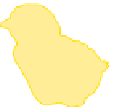Biology Reference
In-Depth Information
(a)
(b)
Green background
Blue background
100
100
Green food
Blue food
75
75
Blue food
Green food
50
50
25
25
0
0
0
4
8
13
0
4
8
13
Trial number
Trial number
Fig. 4.13
Cumulative number of conspicuous and cryptic distasteful prey taken in successive trials by chicks.
In (a) the green food is cryptic, in (b) the blue food is cryptic. In both experiments, by the end of the trial the
distasteful prey has been eaten less when it is conspicuous. From Gittleman and Harvey (1980). Reprinted with
permission from the Nature Publishing Group.
Do prey with repellent defences really benefit from being conspicuous? Gittleman and
Harvey (1980) tested this idea by presenting domestic chicks with different coloured
breadcrumbs. The chicks showed equal preference for blue or green crumbs. In the
experiment, all the crumbs were made distasteful by dipping them in quinine sulfate
and mustard powder. Four groups of chicks were used: (a) blue crumbs on a blue
background or (b) green crumbs on a blue background, and (c) blue crumbs on a green
background or (d) green crumbs on a green background. Whatever the background
colour, the chicks took more of the conspicuous prey early on in the experiment.
However, overall the cryptic prey suffered the greatest predation (Fig. 4.13). This
suggests that it does indeed pay a distasteful prey to be conspicuous. Chicks may learn
to avoid conspicuous prey more readily simply because they are more easily recognized
on account of their bright colour (Roper & Redston, 1987), or the eating of a large
number of prey in a short time may be a more powerful aversive experience than eating
an even greater number of prey over a longer period.
Other experiments have shown that learning to avoid bright noxious prey can
occur after just one trial and last for a long time. Miriam Rothschild had a pet
starling which had just one experience of a brightly coloured distasteful caterpillar
and it still refused to pick this species up a year later even though it had no further
experience in the meantime. Sometimes predators will avoid brightly coloured
and dangerous prey even though they have had no experience of them. For
example, hand-reared 'naïve' flycatchers (the great Kiskadee
Pitangus sulphuratus
)
will avoid coral snakes (
Micrurus
spp.), which are coloured with red and yellow
bands (Smith, 1977).
There may be another advantage for conspicuous warning coloration. Not only can
predators learn to avoid conspicuous colours more easily, but having learned to avoid a
Conspicuous
colours help
predators to learn
to avoid
unpalatable prey
… and may
reduce
recognition errors






























































































































































































































